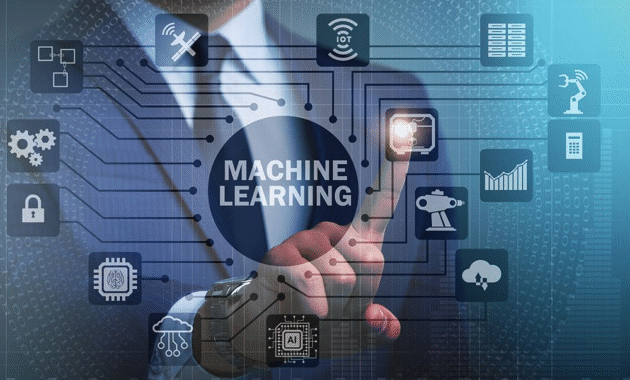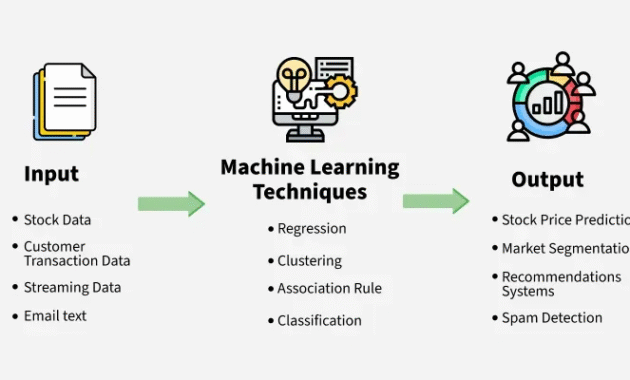Machine learning (ML) is one of the most exciting fields in technology today, powering intelligent systems that can learn from data and make decisions without explicit programming. Whether it’s voice assistants like Siri, recommendation engines on Netflix, or self-driving cars, machine learning is at the heart of many innovations. This beginner’s guide will introduce you to the fundamental concepts of machine learning, its types, how it works, common algorithms, real-world applications, and the future of this dynamic field.
What is Machine Learning?

Definition and Overview
Machine learning is a subset of artificial intelligence (AI) that focuses on developing algorithms that allow computers to learn patterns from data and improve their performance over time without being explicitly programmed to perform specific tasks. Unlike traditional programming, where every rule is manually coded, ML systems automatically identify patterns and make predictions or decisions based on data inputs.
The Relationship Between AI, Machine Learning, and Deep Learning
- Artificial Intelligence (AI): The broader concept of machines performing tasks that require human intelligence.
- Machine Learning (ML): A subset of AI focused on data-driven learning and prediction.
- Deep Learning: A further subset of ML, using neural networks with many layers to model complex patterns.
Types of Machine Learning
Machine learning can be broadly classified into three categories:
Supervised Learning
In supervised learning, the algorithm is trained on labeled data — meaning the input data comes with corresponding correct outputs. The goal is for the model to learn a mapping function from inputs to outputs and make accurate predictions on new, unseen data. Examples include spam email detection, image recognition, and credit scoring. Common algorithms used in supervised learning include linear regression, logistic regression, support vector machines (SVM), and decision trees.
Unsupervised Learning
Unsupervised learning deals with unlabeled data where the system tries to identify hidden patterns or intrinsic structures in the input data. Examples include customer segmentation, anomaly detection, and data clustering. Common algorithms for unsupervised learning include K-means clustering, hierarchical clustering, and principal component analysis (PCA).
Reinforcement Learning
Reinforcement learning involves training an agent to make sequences of decisions by rewarding it for desired actions and penalizing for undesired ones. It learns by interacting with an environment. Examples include robotics, game playing (e.g., AlphaGo), and autonomous driving. Key concepts in reinforcement learning include reward signals, policy, and value functions.
How Does Machine Learning Work?

Data Collection and Preparation
Machine learning starts with data — the foundation of all learning. Data is collected from various sources such as databases, sensors, or web scraping. It then undergoes preprocessing steps like cleaning, normalization, and transformation to prepare it for training.
Feature Selection and Engineering
Features are the attributes or variables that the model uses to make predictions. Effective feature engineering can significantly improve model accuracy by creating meaningful input variables from raw data.
Model Training and Evaluation
The core process involves feeding the prepared data into an ML algorithm to train a model. The model tries to minimize errors and optimize its parameters by learning patterns. After training, models are evaluated on test data to check their accuracy, precision, recall, or other performance metrics depending on the task.
Model Deployment and Monitoring
Once a model performs satisfactorily, it is deployed into production environments where it makes real-time predictions. Continuous monitoring is necessary to detect model drift and ensure consistent performance.
Common Machine Learning Algorithms

Linear Regression
One of the simplest algorithms, linear regression models the relationship between a dependent variable and one or more independent variables by fitting a linear equation.
Logistic Regression
Used for classification problems, logistic regression predicts the probability of a categorical dependent variable.
Decision Trees
A tree-like structure where decisions are made based on feature values, widely used for classification and regression.
Support Vector Machines (SVM)
SVM finds the optimal boundary (hyperplane) that separates different classes in the feature space.
Neural Networks
Inspired by the human brain, neural networks consist of interconnected layers of nodes (neurons) and are capable of learning complex non-linear patterns.
Real-World Applications of Machine Learning
Healthcare
Machine learning aids in disease diagnosis, personalized treatment plans, and drug discovery by analyzing medical images and patient data.
Finance
Fraud detection, credit risk assessment, algorithmic trading, and customer segmentation rely heavily on ML models.
Retail and E-commerce
Recommendation systems, inventory management, and customer sentiment analysis enhance customer experience and operational efficiency.
Autonomous Vehicles
Self-driving cars use reinforcement learning and computer vision to navigate safely in real environments.
Natural Language Processing (NLP)
Voice assistants, chatbots, and language translation services leverage ML to understand and generate human language.
Challenges in Machine Learning
Data Quality and Quantity
Good data is crucial. Incomplete, biased, or insufficient data can lead to poor model performance.
Overfitting and Underfitting
- Overfitting: Model learns training data too well including noise, leading to poor generalization.
- Underfitting: Model is too simple to capture underlying patterns.
Interpretability
Some ML models, especially deep neural networks, are black boxes—hard to interpret or explain decisions.
Ethical Concerns
Bias in data and models can lead to unfair or discriminatory outcomes. Ensuring fairness and transparency is critical.
The Future of Machine Learning
Automated Machine Learning (AutoML)
Tools that automate model selection, hyperparameter tuning, and deployment will make ML accessible to non-experts.
Explainable AI (XAI)
Developing models that provide clear reasoning behind predictions to build trust and comply with regulations.
Edge Computing
Running ML models on devices (like smartphones) locally to reduce latency and enhance privacy.
Integration with Other Technologies
Combining ML with IoT, blockchain, and augmented reality will open new possibilities.
Also Read : How Businesses Can Build A Robust Cybersecurity Strategy
Conclusion
Machine learning is revolutionizing the way machines interact with the world, providing systems that learn and improve from data. Understanding the basics—types of learning, key algorithms, and workflows—is essential for anyone interested in this field. Despite challenges like data quality and ethical issues, the future of machine learning is bright, with continuous innovations making AI smarter, more transparent, and more accessible. For beginners, the journey into machine learning starts with grasping foundational concepts and experimenting with real datasets. As you delve deeper, the scope of intelligent systems you can build is practically limitless.
FAQs
What is the difference between machine learning and traditional programming?
Traditional programming uses explicit instructions coded by humans. Machine learning uses data and algorithms to automatically learn patterns and make predictions without explicit programming.
What programming languages are best for machine learning?
Python is the most popular due to libraries like TensorFlow, PyTorch, and Scikit-learn. R, Java, and Julia are also used depending on the application.
How much data do I need to train a machine learning model?
It depends on the complexity of the task and model. Simple models require less data, but deep learning often requires large datasets to perform well.
Can machine learning models be biased?
Yes. If training data contains biases, the model may learn and perpetuate them. Careful dataset curation and fairness checks are important.
Is machine learning only for tech experts?
No. With platforms like Auto ML and accessible online courses, beginners without deep technical backgrounds can start learning and applying ML concepts.




